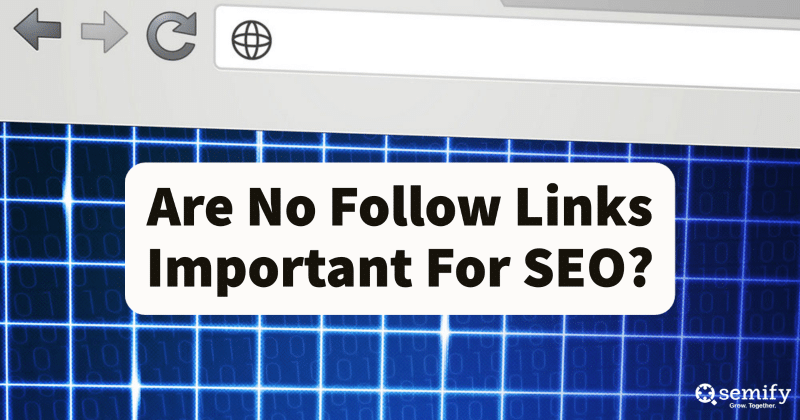
Link-building is an important part of any client SEO strategy. After all, Moz data reveals that off-site SEO factors are likely to represent more than 50% of ranking factor weight. Therefore, any white label SEO agency will tell you that the work you do off-site matters just as much (if not more than) the on-site optimizations you’re making.
Building backlinks can be a great way to improve the domain rating of your client’s site. As we’ve learned, there are two main types of links you can build – follow and no-follow. We’ve broken down the basics of no follow vs follow links before, but we’re still haunted by a frequently asked question: Are no follow links useless for your SEO strategy?
Quick Refresher: No-Follow Links
Let’s quickly re-introduce the idea of link attributes. When a link is a do-follow, it passes along “link juice” from the referring domain. That means the first site gives a thumbs up to the second. Google will perceive the site being linked more favorably because the referring domain is willing to endorse it.
When a link contains a no-follow attribute, on the other hand, it’s essentially telling Google that the domain publishing that link does not endorse it. It’s not saying the link is bad, but it suggests that the referring site doesn’t want to give the link its seal of approval (for whatever reason). The no-follow link will theoretically not receive the “link juice” from the referring website in this scenario.
No-follow links can come from a wide variety of websites. Some sites (like many news outlets or large brands) treat all outgoing links as no-follow, while others will pick and choose which links they’ll provide a do-follow attribute to. For example, some websites might only provide do-follow links to educational resources, government agencies, or unbiased industry organizations. Another website might be happy to provide a do-follow link to a non-competitor with a great resource to share.
If you use a service like Ahrefs, you can determine which backlinks are no-follow by looking at your referring domains. You can also examine the source code of a given website to determine whether a link has a no-follow attribution in its URL structure. It’ll look like this:

Contrary to what some people believe, no-follow links aren’t bad. You’ll naturally find no-follow links in most backlink profiles, and they do serve a few important purposes.
Are No Follow Links Important For SEO?
We often hear from folks who ask, “are no follow links useless for my clients?” We’re inclined to answer no because:
- No follow links can drive traffic to your client’s site
- No follow links can assist in creating a more natural (less spammy) backlink profile
- No follow links can keep a website from receiving a Google penalty
- No follow links may still pass some sort of value from one domain to the other
Are they as valuable as do-follow links? Typically, no. But they usually won’t hurt your SEO when used in moderation. In some ways, they can help you by allowing you to avoid penalizations or to raise brand awareness and conversions.
But how much do no-follow links factor into how a website’s value is determined?
Semify’s Original Research: How No-Follow Links Impact Backlink Profiles and Overall SEO
Understanding the true impact of no-follow links is a huge undertaking – and it’s an area without much clarity. We wanted to perform some original research to see whether we could illuminate some truths about how much no-follow links impact SEO. (Spoiler alert: we now have more questions than answers.)
Looking Deeper Than DR
We started with some data we sourced directly from an Ahrefs post discussing how domain rating is calculated. In that article, we learned that three popular websites have something in common:
- huffingtonpost.com = DR 92 (93.7 million backlinks)
- techcrunch.com = DR 92 (97 million backlinks)
- salesforce.com = DR 92 (113 million backlinks)
Yep, these very different websites all have the same domain rating. But DR doesn’t tell the full story. DR ranks a website on a scale from 0 to 100 based on the size and quality of its backlink profile; however, it doesn’t compare backlink profile strength relative to other websites.
According to data compiled by Ahrefs (using Ahrefs Rank, the platform’s ordering system based on backlink profile strength), HuffPost’s backlink profile is actually stronger – despite its lower number of referring backlinks – than those of both TechCrunch and Salesforce. HuffPost has an AR of 316, while TechCrunch comes in right behind at 317. Salesforce, conversely, has an AR of 346 and has the highest number of referring backlinks, suggesting that its link-building strategy may prioritize quantity over quality.
Do-Follow Links = A Stronger Backlink Profile (Despite Questionable Practices)
When we take a closer look at the backlink profiles for these websites, this assumption seems to ring true. Of Salesforce.com’s 273,130 referring domains, roughly 209,919 (or 77%) of them are do-follow links. TechCrunch , on the other hand, has 603,200 referring domains – 558,304 (or 93%) of which are do-follow. When we examined HuffPost’s referring domains, we found a similar ratio: out of 1,022,251 referring domains, 973,865 (or 95%) provided do-follow links.
Salesforce:
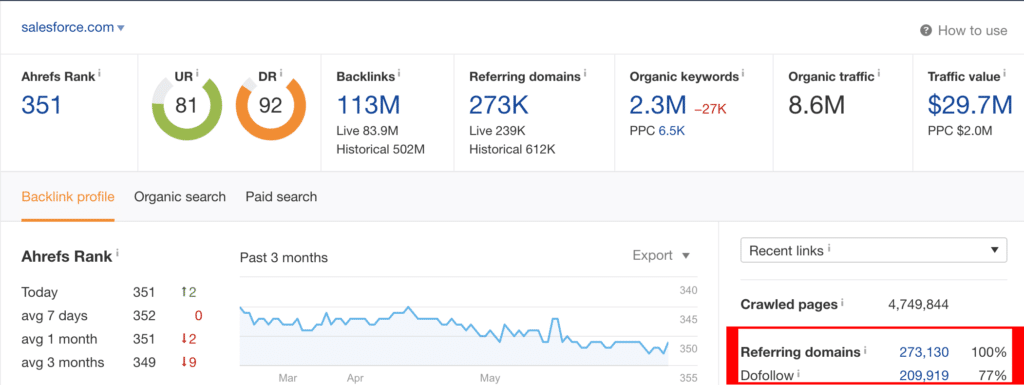
TechCrunch:
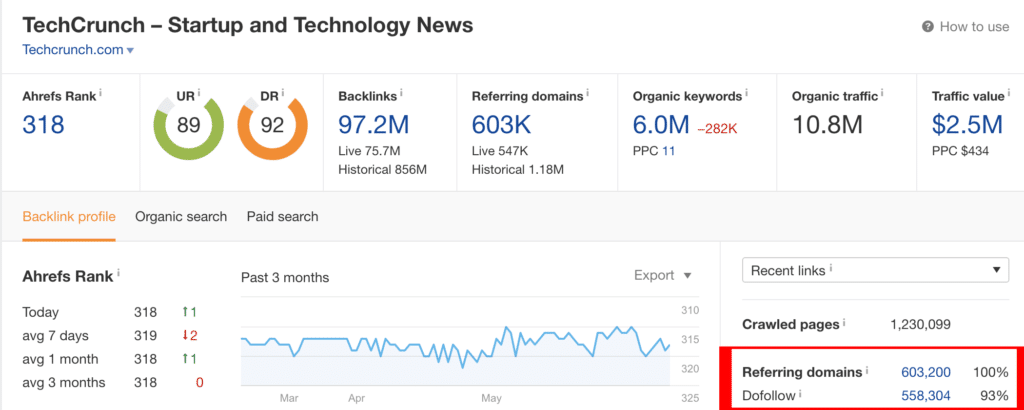
Huffington Post:
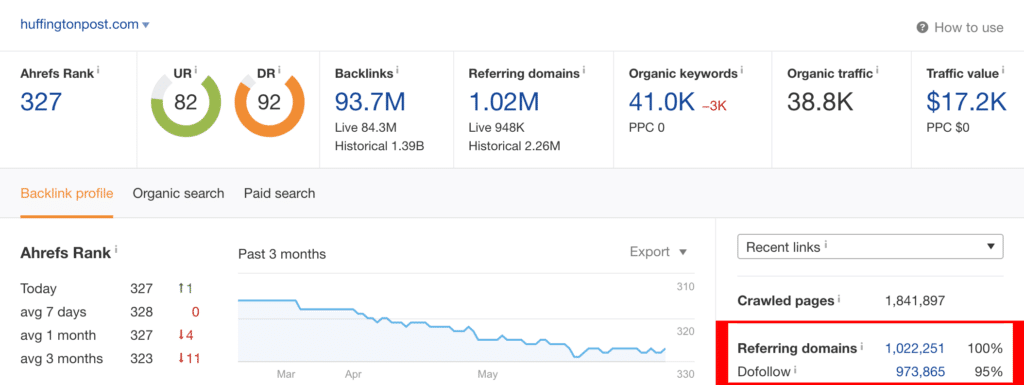
With this data in mind, it’s clear that having more do-follow links can often have a positive impact on domain rating and backlink profile strength. (No surprise there!) Having a higher percentage of do-follow referring domains correlates with a higher DR. Thus, we’d conclude that having a higher percentage of no-follow links in a site’s backlink profile won’t be quite as beneficial to its SEO (or at least this particular calculation).
That said, things get interesting when you take a closer look at the referring domains. Here’s a peek at some of huffingtonpost.com’s most recent do-follow referring domains:
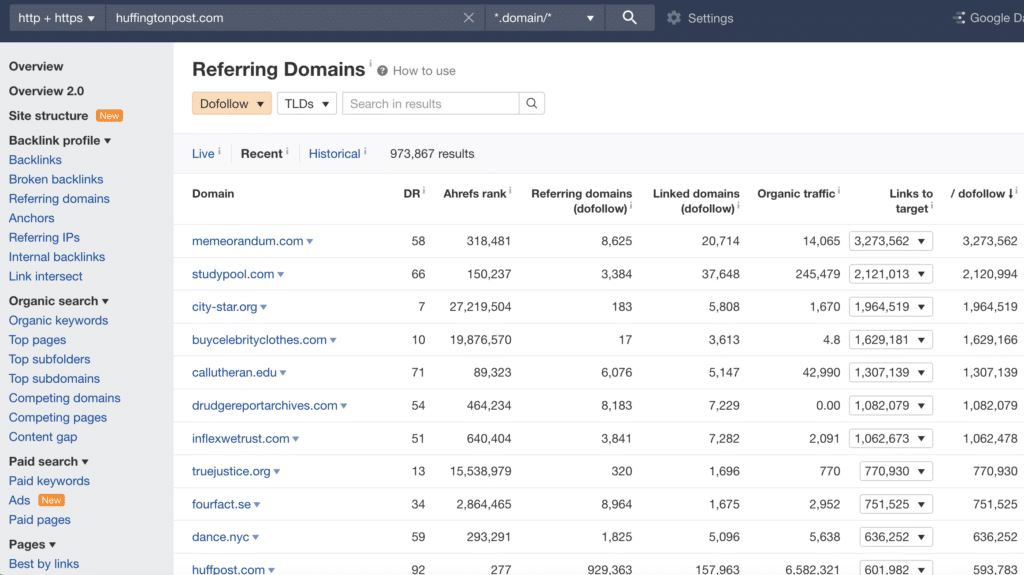
There are some sites with decent DRs listed, but all of those DRs are lower than that of HuffPost itself. There are also some low-DR websites there, like city-star.org, buycelebrityclothes.com, and truejustice.org. Despite two of those URLs having .org domain extensions, it seems Google doesn’t find them to be particularly valuable. What’s more, these referring domains run the gamut in terms of vertical (which may be expected, considering that HuffPost is a massive news outlet that covers a wide array of topics).
Now, let’s do the same thing for TechCrunch. Relevance aside, we’re seeing a similar pattern. There are a few DRs that are relatively high (though still less impressive than TechCrunch’s own DR), with some very low DRs mixed in. Again, these are all from do-follow links.
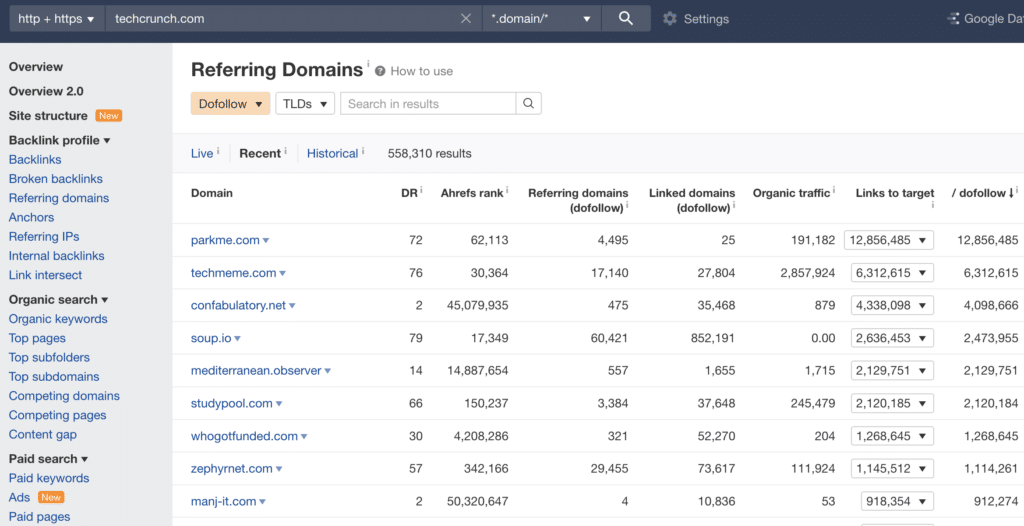
Another interesting thing to note is that the top-listed websites in these examples are pointing an unfathomably large number of links at our DR-92 examples. In the screenshot above, you’ll see that parkme.com (which essentially functions as a map directory website) has published 12,856,485 do-follow links that direct to TechCrunch. Even though TechCrunch may not be actively going after 12 million links from one domain, it’s not something we’d ever personally advise doing for SEO – and yet, it hasn’t seemed to hurt the site’s DR very much.
And what about the do-follow referring domains for Salesforce, the site with the weakest backlink profile? You might be inclined to think this site has a stronger profile if you were to use only the site’s recent referring do-follow domains as a reference point:
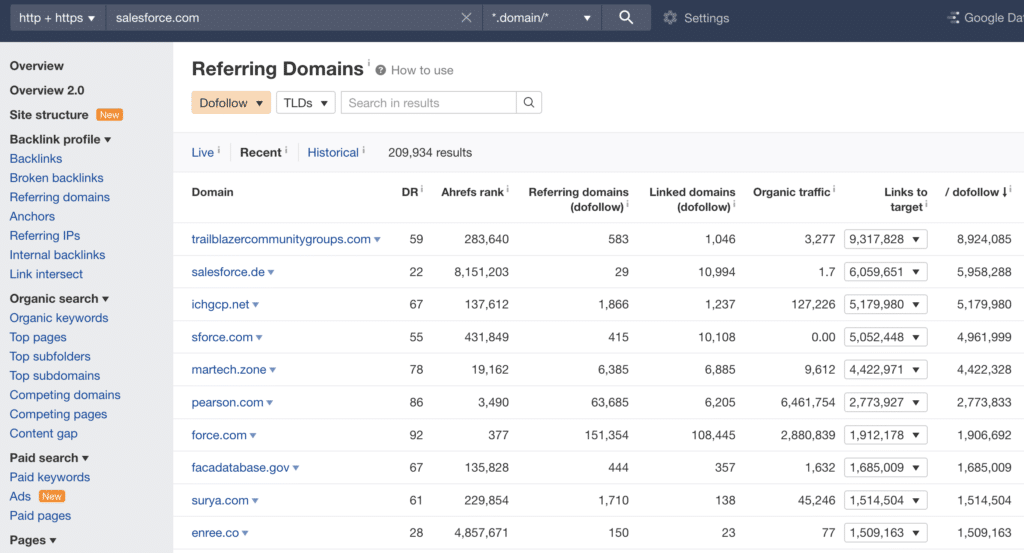
Generally speaking, this short list of DRs seems more impressive than the other two. The DRs are higher, at least. But as we continued to scroll down the list, we did find some very low-DR websites, as well. Many of the referring domains seem to be based outside of the U.S., with several URLs containing similar structures, as seen here:

When you consider only DR, having thousands of links coming from salesforce.de or these coolshop sites may seem like they’re better than the top referring websites for HuffPost and TechCrunch. But domain rating doesn’t paint the whole picture – and there’s more than one way to succeed at SEO.
Additionally, it’s tough to view these do-follow links in a vacuum. How do we know how Google weighs one link over another? Does Google care that these sites receive thousands of do-follow links from websites that aren’t particularly relevant or valuable? And even if Google does care, are those thousands of links being offset by other, better links somewhere in the site’s backlink profile? It’s nearly impossible to tell for websites that are this established.
No-Follow Links = No Clear-Cut Answer on Significance
But for the sake of argument, let’s look at the domains that are providing no-follow links to these sites. We expected to see some low-quality, spammy websites here. For example, even though it has a relatively high domain rating of 79, soup.io is clearly a private blog network. (Interestingly, TechCrunch has both do-follow and no-follow links from this site in its backlink profile.)

PBNs are controversial because they can serve a purpose (i.e., passing link juice), but they can also be lacking in organic traffic and overall content value if they’re poorly maintained. It’s possible that this site is scraping TechCrunch’s content and reposting it independently. Again, it’s hard to believe that TechCrunch would be purposely going after over 2 million links from one website – no-follow or not.
TechCrunch does have a couple of good referring domains in the no-follow section of its backlink profile, including several Yahoo! URLs, socialmediatoday.com, Business Insider Australia, and Search Engine Land. Again, these sites reportedly don’t pass any link juice – but it’s possible that having them included might provide some sense of legitimacy (or diversity, if nothing else). But if those links truly aren’t being followed, it’s unclear whether they add much meaningful value.
As you can imagine, our heads were spinning at this point. What does it all mean? Other than helping you create a more natural-looking backlink profile and potentially driving some traffic to your site, are no-follow links worth getting? Can they actually help your SEO in a way that’s significant enough to warrant a place in your link-building strategy?
What Other Experts Say About No-Follow Links
We decided to see what others in the industry have to say on this subject. Neil Patel boldly claims that Google has likely incorporated no-follow links into its algorithm in some way, meaning that no-follows almost certainly have an impact on SEO:
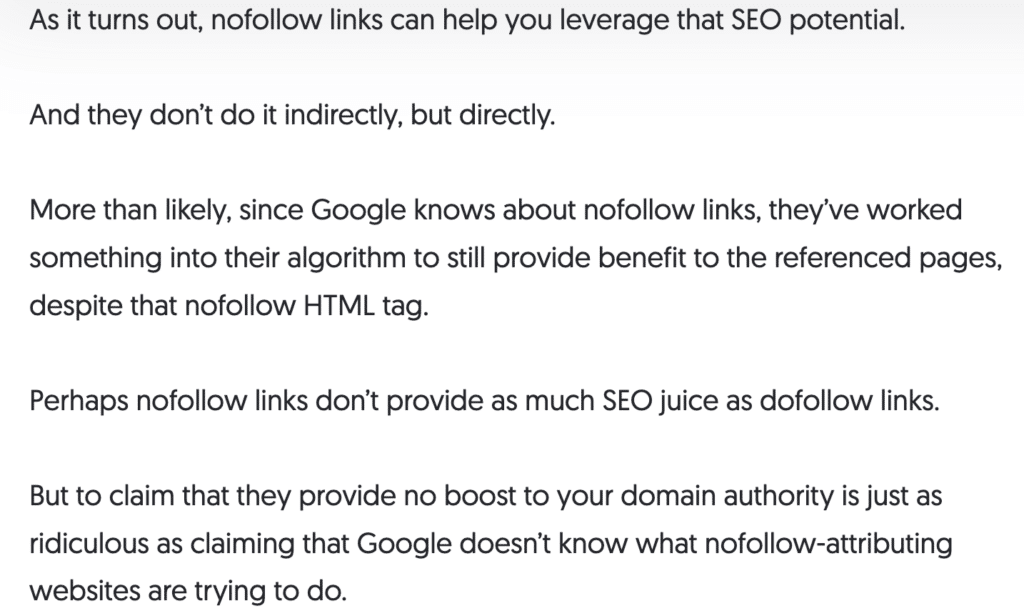
And here’s what Search Engine Journal reported when Google amended how it counts no-follow links back in 2019:
“Previously nofollow links were treated as a directive, meaning Google obeyed the nofollow, period. Starting today, for ranking purposes, Google is treating nofollow as a hint. This means that Google will decide whether to use the link for ranking purposes or not. This change impacts on-page SEO, content marketing, link building and link spam.”
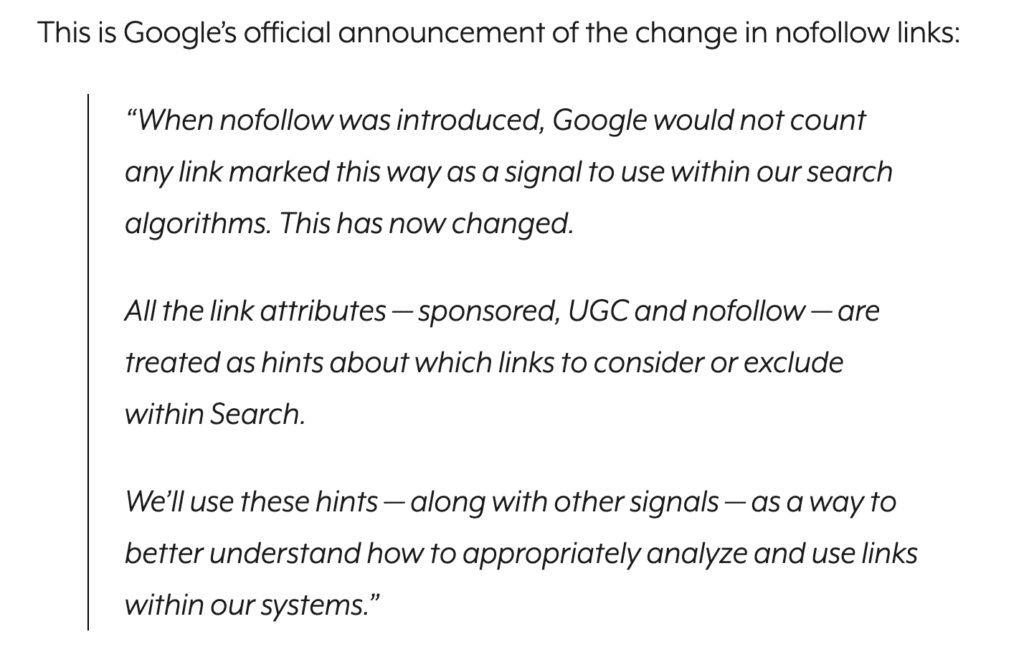
Google, vague as ever, seems to answer the “are no follow links important?” question with an infuriating “it depends.” But what we do know is that there’s no longer a strict policy that keeps Google bots from following no-follow links. Now, there’s a chance (no matter how slim) that these links will still “count” towards how your site is ranked. The directive is now merely a suggestion, rather than a steadfast rule.
Finally, Semrush published some original research that suggests high-ranking websites have ample no-follow links pointing to them:
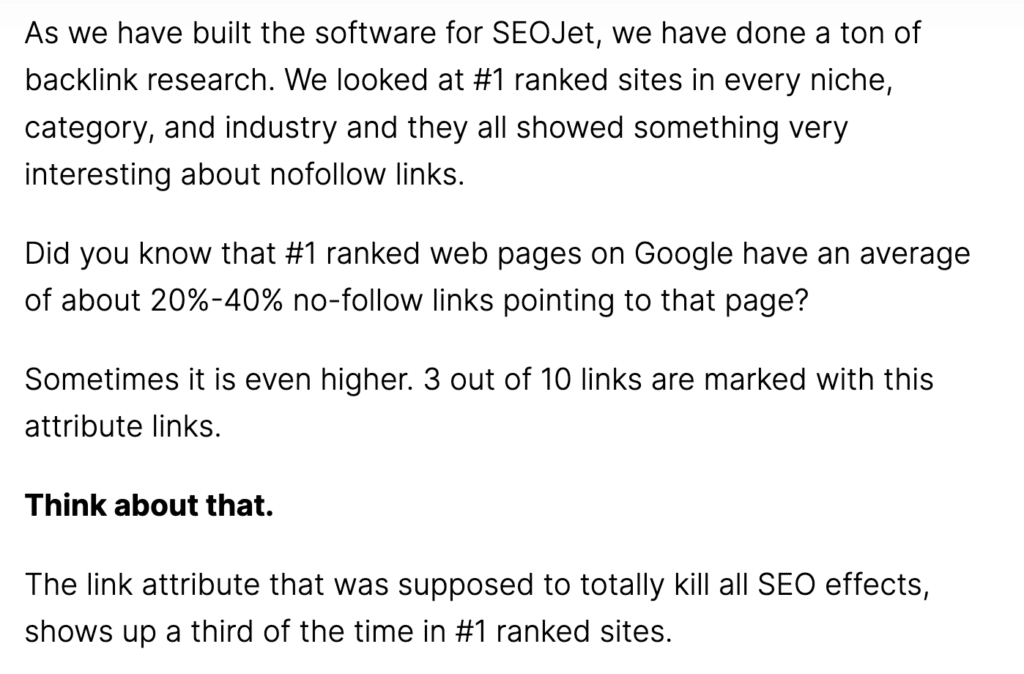
According to their data, about 20% to 40% of the backlinks pointing to #1-ranked sites in SERPs are no-follow links. Clearly, no-follow links aren’t hurting the SEO of these sites. These links are arguably necessary; the question is how big of an impact they might have.
When we analyzed the backlink profiles of those three well-known sites, it seemed obvious to us that having more do-follow links resulted in a stronger backlink profile. But are no follow links useless? We’d say no! Although we weren’t able to discern whether a specific no-follow link from a reputable, high-DR website has a measurable impact on a site’s ranking factors, general wisdom tells us that you’ll still want some to appear in your backlink profile.
Keep in mind that a site’s ability to pass link juice value actually depends on how many domains that site links out to with do-follow links. Even if you get a do-follow link from a high-DR site, the effects on your own DR will be diminished if that site provides do-follow links to just about anyone who asks. While that do-follow link probably won’t hurt, it also won’t make your DR jump a significant amount. In some cases, it may not be that much more beneficial to get a do-follow link than a no-follow link from a national news outlet – so even if the site isn’t officially endorsing yours, don’t panic! As with any SEO topic, multiple factors are considered here.
A Final Word on No-Follow Links
Ultimately, we can’t go so far as to say that no-follow links will definitely improve a site’s ranking. But we also can’t claim that no-follow links have zero effect on SEO. Even if a link is not technically followed (or “counted” in the eyes of Google), it can still improve your backlink profile’s organic perception and drive traffic to your site. In order to reap those benefits, however, you’ll want your no-follow links to be from reputable, relevant sites that have a tangible readership.
Should you turn down a no-follow link opportunity? If it’s from a website with a low DR that’s irrelevant to your niche, or if you already have a lot of no-follow links in your backlink profile, you’d probably be better off skipping it and trying to get a do-follow elsewhere. But if the site is relevant, has good traffic and a decent DR, and doesn’t require you to pay or spend lots of time on content creation, you might consider it if your backlink profile lacks no-follow links. Whether or not link juice comes into play, you could still boost sales or brand awareness if your audiences overlap.
Our takeaway: No-follow links can be useful, but they shouldn’t be the main focus of your link-building strategy. As with countless other digital marketing topics, there’s nuance and balance needed. Before you dismiss a potential backlinking opportunity just because of its attribute, work with your white label SEO agency to look beyond the no-follow and assess whether it could help (or hurt) your clients in other ways.